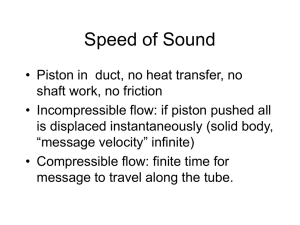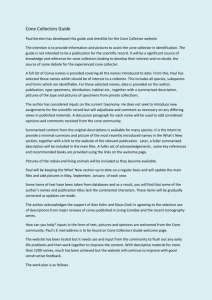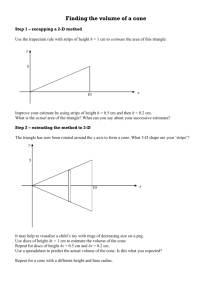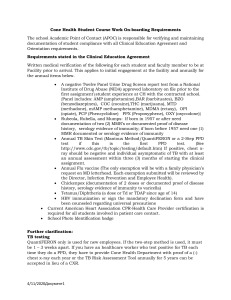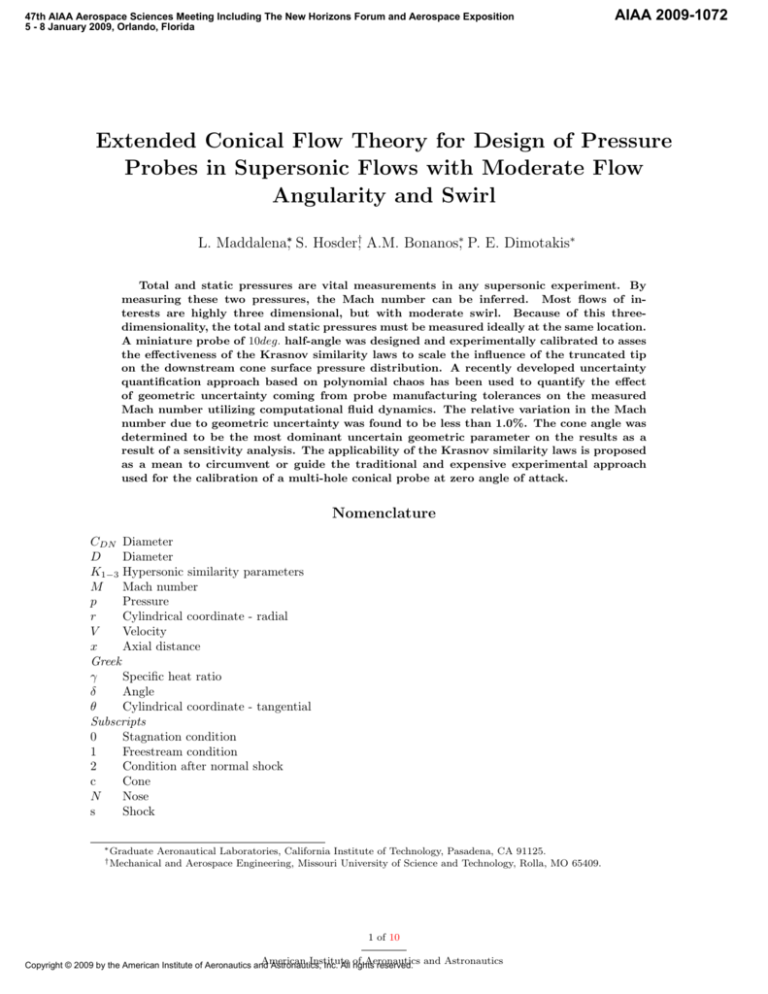
47th AIAA Aerospace Sciences Meeting Including The New Horizons Forum and Aerospace Exposition
5 - 8 January 2009, Orlando, Florida
AIAA 2009-1072
Extended Conical Flow Theory for Design of Pressure
Probes in Supersonic Flows with Moderate Flow
Angularity and Swirl
L. Maddalena∗, S. Hosder†, A.M. Bonanos∗, P. E. Dimotakis∗
Total and static pressures are vital measurements in any supersonic experiment. By
measuring these two pressures, the Mach number can be inferred. Most flows of interests are highly three dimensional, but with moderate swirl. Because of this threedimensionality, the total and static pressures must be measured ideally at the same location.
A miniature probe of 10deg. half-angle was designed and experimentally calibrated to asses
the effectiveness of the Krasnov similarity laws to scale the influence of the truncated tip
on the downstream cone surface pressure distribution. A recently developed uncertainty
quantification approach based on polynomial chaos has been used to quantify the effect
of geometric uncertainty coming from probe manufacturing tolerances on the measured
Mach number utilizing computational fluid dynamics. The relative variation in the Mach
number due to geometric uncertainty was found to be less than 1.0%. The cone angle was
determined to be the most dominant uncertain geometric parameter on the results as a
result of a sensitivity analysis. The applicability of the Krasnov similarity laws is proposed
as a mean to circumvent or guide the traditional and expensive experimental approach
used for the calibration of a multi-hole conical probe at zero angle of attack.
Nomenclature
CDN Diameter
D
Diameter
K1−3 Hypersonic similarity parameters
M
Mach number
p
Pressure
r
Cylindrical coordinate - radial
V
Velocity
x
Axial distance
Greek
γ
Specific heat ratio
δ
Angle
θ
Cylindrical coordinate - tangential
Subscripts
0
Stagnation condition
1
Freestream condition
2
Condition after normal shock
c
Cone
N
Nose
s
Shock
∗ Graduate
Aeronautical Laboratories, California Institute of Technology, Pasadena, CA 91125.
and Aerospace Engineering, Missouri University of Science and Technology, Rolla, MO 65409.
† Mechanical
1 of 10
American
Institute
Aeronautics
Copyright © 2009 by the American Institute of Aeronautics and
Astronautics,
Inc. All of
rights
reserved. and Astronautics
I.
Introduction
Ever since the experiments of Torricelli and Pascal in the mid 17th century, who attributed the height of
a column of liquid to an external force from the atmosphere and invented the barometer, means of measuring
the effect of presence or flow of fluids have been pursued. About a century later, Bernoulli stated that an
increase in a fluid’s velocity is related to a drop in pressure or a change in potential energy.
This principle is applied in Pitot-static tubes, used to measure the difference between total and static
pressure, which in turn can be related to fluid velocity. A schematic of such a probe is presented in Fig. 1.
Several improvements have been made throughout the years on the basic design of the Pitot-static tube, but
the basic principle remains the same: by measuring the total and static pressures, the flow Mach number
can be inferred, either through Bernoulli’s equation or through the isentropic relation. The remainder of
this report focuses primarily on Mach number measurements in supersonic streams with low angularity.
Total pressure port
Static pressure port
Figure 1. Schematic of a Pitot-static pressure probe.
When measurements are made in supersonic streams, additional complications arise due to the presence of
a normal shock in front of the probe. Specifically, for pressre probes, the simplest scheme to circumvent this
problem is to separate the total and static measurements into individual probes, and use the Rayleigh-Pitot
formula1 to derive the Mach number, i.e.,
p
=
p0,2
2γ
2
γ+1 M1
−
γ−1
γ+1
1/(γ−1)
γ+1
2 γ/(γ−1)
2 M1
(1)
where p is the static pressure, p0,2 is the total pressure measurement downstream of the normal shock and
M1 is the (desired) freestream Mach number.
Splitting the total and static probes is sufficient to resolve two-dimensional flows, but not three-dimensional
ones. The shape of the shock in front of the probes governs the closest distance they can be placed, and
imposes a fundamental limit on the spatial resolution of the measurements. For three-dimensional flows,
experiments can be repeated by alternating the probes between two runs, however this causes a significant
increase in cost and time.
Further, even if the flow is two-dimensional, the static pressure ports must be placed quite a distance
downstream of the probe tip, to avoid measuring erroneous pressures due to the influence of the shock.
Typical locations for the static pressure ports are 6-10 probe diameters downstream of the tip.2 In physically
small, high Reynolds number facilities, such as inlets or model flowfields, significant axial variation of static
pressure and flow direction frequently occur in much smaller distances. This results in the probe tip and
static ports not being in the same flow environment and thus degrading the accuracy of the measurement.
Pinckney3 proposed a design to reduce the distance at which the static portss must be placed, based
on a conventional static pressure probe with a conical tip that transitioned to a cylinder. By introducing a
fairing that smoothed out this transition from cone to cylinder, Pinckney was able to reduce the tip to static
port distance. Despite the reduced length to the static ports, the design is fairly complex to machine and
exhibits sensitivity to the freestream Mach number.
Another type of probe used in supersonic streams is the cone-static probe, which measures pressure on
the surface of a cone in order to determine the Mach number of the incoming freestream. This type of probe
takes advantage of the analytical solution derived by Taylor and Maccoll4 for axisymmetric irrotational flow
2 of 10
American Institute of Aeronautics and Astronautics
over a cone, given by
γ−1
2
h
1 − Vr2 −
dVr 2
dθ
ih
2Vr +
h
dVr
r
− dV
dθ Vr dθ +
dVr
dθ cot(θ)
dVr d2 Vr
dθ dθ 2
i
+
d2 Vr
dθ 2
i
=0
(2)
where r and θ are the radial and tangential unit vectors in spherical coordinates and Vr is the radial velocity
component, as shown in Figure 2.
Vr
Vθ
M1
δc
δs
pc
Figure 2. Schematic of supersonic flow over a cone.5
This is an ordinary differential equation for Vr , however it does not have a closed form solution and thus
r
needs to be solved numerically. The tangential velocity component is given by Vθ = dV
dθ . Note that Vr and
Vθ are normalized velocity components that can be related to the Mach number on the surface of the cone,
Mc , through
−1/2
q
2
2
2
V = Vr + Vθ =
+1
.
(3)
(γ − 1)Mc2
The equation is solved numerically. The Mach number on the cone surface can be used to determine the
pressure on the surface of the cone, through the isentropic relation.
In an experimental setup, the cone-static pressure can be measured but the freestream Mach number is
unknown. Therefore the Taylor-Maccoll equation is solved to determine the possible pressures that can exist
on a cone of a given angle, and then the solution is used as a look-up table to find the Mach number, through
the experimentally measured value of the pressure. However, an independent measure of the freestream total
or static pressure is required in order to relate the pressure on the cone to the static pressure of the flow and
deduce the free-stream Mach number.
An interesting side note for this type of probe arises from the work of Krasnov.5 Using a similarity
parameter typically employed in hypersonic flow, namely K1 = M1 sinδc , he was able to come up with the
following algebraic expression for the ratio of cone-to-free-stream static pressure
pc
= 1.493K11.98 + 1.302
p1
(4)
obviating the need for a numerical solution of the Taylor-Maccoll equation. Note that this formula was
derived for γ = 1.405 and is valid for K1 < 6. The approximation becomes better with increasing cone
half-angle and increasing Mach number, as illustrated in Figure. 3.
II.
Conical Probe with Blunt Nose
The influence of a truncated tip (Figure 4) on the downstream cone surface pressure distribution is
examined here. Due to the corner expansion, the flow around a cone with flat nose results in a lower pressure
region behind the tip compared to a sharp cone of the same half-angle. Beyond this portion affected by flow
expansion, the pressure distribution will quickly recover to that of a sharp cone. Therefore, the position of
the surface orifices is important in determining whether the pressure taps are at a sufficient distance away to
have readings as predicted by the sharp cone theory. Chernyi6 solved the problem of a steady flow around a
slender cone at hypersonic velocity problem by using the analogy of the unsteady motion of the gas behind
the cylindrical shock wave originating in front of a piston. According to this analogy, the perturbed flow
3 of 10
American Institute of Aeronautics and Astronautics
7
δc=10 , Taylor-Maccoll
o
δc=10 , Krasnov
δc=15o, Taylor-Maccoll
δc=15o, Krasnov
o
δc=20 , Taylor-Maccoll
δc=20o, Kransov
o
6
pc / p1
5
4
3
2
1
0
2
2.5
3
3.5
4
4.5
5
M1
Figure 3. Solution of Taylor-Maccoll equation (symbols) compared to Krasnov’s curve fit (lines) for three
different cone half angles for 2 ≤ M1 ≤ 5.
around a cone is equivalent, in a lateral plane stationary with respect to the body, to the gas flow in front of
a piston. For observers located in this plane, the flow is similar to the flow that originates in the propagation
of an explosion wave.
Figure 4. Flat nose schematic
Krasnov indicated that for a slender blunt cone it is necessary to include the cone angle δc in the set
of parameters that define the motion. It can be done by adding the similarity parameter K1 = M∞ δc to
the number of dimensionless parameters on which the flow depends. These dimensionless parameters then
determine the dimensionless characteristics of the flow. Therefore, the pressure coefficient at the cone surface
is given by the general relation:
Cp
2(p − p∞ )
=
= P (x∗ , K1 , γ)
2 δ2
δc2
ρ∞ V ∞
c
(5)
where
1
x∗ = 2 √
M∞ CDN
x
DN
1
=
K3
x
DN
(6)
This can be considered the longitudinal coordinate (in a similar way Krasnov provides the similarity law
for the radial coordinates of the shock wave). According to the similarity rules, the dimensionless quantity
in Equation 6 for cones having different values of δc and DN will be identical for equal relative coordinates
xN , if the similarity parameters K1 and K3 are maintained the same. The Krasnov universal curve was
constructed on the basis of the previous considerations and using experimental data. According to the
similarity law, this curve can be used for the calculation of pressure for cones of different blunting.
The similarity law is not valid for the entire surface of the body. In fact, a complex phenomenon, which
cannot be represented by the similarity law, is observed in the flow around a cone in the vicinity of the flat
face. Flow separation occurs directly behind the corner, and a stagnant region develops. The flow eventually
4 of 10
American Institute of Aeronautics and Astronautics
reattaches itself to the surface. The deflection caused by the diversion of the flow in this zone is accompanied
by the development of a local shock wave. The pressure decreases due to the expansion across the corner
and rapidly increases passing through the shock wave. After achieving a maximum, the pressure begins to
decrease again.
III.
Current Probe Design and Calibration
The purpose of this investigation is to asses the effectiveness of the Krasnov similarity laws as a mean
to circumvent or guide the traditional experimental approach used for the calibration of multi-hole probes,
which is vastly demanding on resources.
The determination of the functional curve M = f (Pc /P0,2 ), which represents the relation between the
Mach number and the ratio of the measured pressures, is of primary importance. This characteristic curve
is also essential for multi-hole probes used for angularity measurements, since it is integral part of the data
reduction process.
Figure 5. Schematic of the probe
The probe in Figure 5 was designed at Caltech and manufactured by United Sensors Inc. The design is
based on a truncated, conical tip that transitions to a cylinder. The cone has a half-angle of 10deg and the
cylindrical body has a diameter of 0.0625in. The four static pressure ports are located and normal to the
cone surface. They are at a distance of 0.095in from the truncated tip and have a diameter of 0.012in. They
are placed at 90deg to each other. The static pressure ports lead to a common plenum, “Plenum A”, and
are used to measure the static pressure on the cone surface, Pc . The central port with a diameter of 0.18in
is used to measure the total pressure, P0,2 , downstream of the normal shock that will be stand in front of
the probe, when it is placed in a supersonic freestream.
This geometry reveals that the pressure ports are situated at x/DN = 4.25, well within the region
influenced by the nose, therefore causing discrepancy between the conical theory and the experimental
measurements. Figure 7 shows the Krasnov prediction for the blunt tip and the numerical solution of the
correspondent pointed cone.
The probe was calibrated using the variable Mach number supersonic wind tunnel at the University
of Texas at Austin, in order to determine uniquely the local values of Mach number and total pressure as
functions of the measured orifice pressures. Wind tunnel plenum pressure and test section wall static pressure
measurements where used to determine the Mach number. Several tests where conducted for different Mach
numbers, with the probe aligned with the flow, from M = 1.75 (lower limit imposed by the blockage produced
by probe support in the test section) to M = 3.
Schlieren photographs where taken for each run (Figure 6). The information provided by the flow
visualizations where used as an independent way to determine the Mach number and to asses the flow
conditions in particular for the Mach numbers near the lower operating limit.
5 of 10
American Institute of Aeronautics and Astronautics
Figure 6. Schlieren visualizations representing the effect of the probe’s blockage (left) and a typical supersonic
test (right).
The characteristic of the probe is presented in Figure 7 and represents the relation between the Mach
number and the ratio Pc /P0,2 , where P0,2 is the central port pressure and Pc is the pressure measured from
the port connected with the four peripheral holes of the probe’s tip. Each experimental point is presented
with a vertical and horizontal error bar which indicate one standard deviation of uncertainty. Figure 7 reveals
a close agreement of the calibration predicted using the similarity laws of Krasnov and the experimental data.
3.5
Krasnov
Pointed cone
Mach number
3
2.5
2
1.5
0.05
0.1
0.15
0.2
0.25
P /P
c
0.3
0.35
0.4
0,2
Figure 7. Experimental calibration data (dots) compared with the results derived using the Krasnov universal
curve, and the numerical solution of the correspondent pointed cone.
IV.
Prediction of the Uncertainty in the Probe Measurements due to
Geometric Uncertainty
In the current study, the uncertainty analysis has been focused on the quantification of the variation
in the measured Mach number due to the geometric uncertainty of the probe that may originate from the
manufacturing tolerances. The main geometric parameters considered in the uncertainty analysis are the
cone angle (δc ), the nose diameter (DN ), and the the distance of the static ports from the tip of the probe
(xc ). Based on the information obtained from the probe manufacturer, the cone angle was modeled as a
uniform random variable between 9.5o and 10.5o with a mean of 10o , the nose diameter was modeled as a
6 of 10
American Institute of Aeronautics and Astronautics
Table 1.
The Latin Hypercube Monte Carlo and Point-Collocation NIPC (p = 2) statistics for the Mach
Number M1 . The 95% confidence intervals for the MC statistics were calculated using the Bootstrap method.
Statistics
MC
95% Confidence Interval of MC
Point-Collocation NIPC (p = 2)
Mean
Standard Deviation
Coefficient of Variation
1.95516
0.014360
0.0073448
[1.95427, 1.95602]
[0.013897, 0.014809]
[0.0071139, 0.0075787]
1.95513
0.014691
0.0075138
uniform random variable between 0.01700 and 0.02700 with a mean of 0.02200 , and the static port distance
measured on the cone surface from the nose xc was modeled as a uniform random variable between 0.09000
and 0.1000 with a mean value of 0.09500 . Uncertainty quantification utilized Euler calculations performed
with the CFD Code GASP7 to numerically simulate the flow field around a number of probe geometries each
resulting from a unique set of geometric parameters in random space at a free-stream Mach number of 2.0, at
zero degrees angle of attack assuming axis-symmtric flow. The flow solution (in particular, the total and the
static pressures) for each probe geometry were used in a recently developed Point Collocation Non-Intrusive
Polynomial Chaos8, 9 (NIPC) method to quantify the uncertainty in the measured Mach number M1 as
well as the other output variables such as the static pressure distribution on the cone surface. The Point
Collocation NIPC is an advanced uncertainty propagation technique, which is based on the general theory
of Polynomial Chaos. It has significant benefits over traditional uncertainty propagation techniques such
as the Monte-Carlo and moment methods in terms of computational efficiency and accuracy. The detailed
information on the Point Collocation NIPC method and the uncertainty analysis applied to the current
supersonic probe geometry can be found in Hosder and Maddalena.10 The following section gives a brief
description of the important results obtained from the uncertainty analysis.
A.
The Results of the Uncertainty Analysis
Table 1 gives the statistics summarizing the uncertainty in the Mach number M1 obtained with PointCollocation NIPC of order 2 and the Latin Hypercube Monte Carlo simulations which were performed for
comparison and the verification of the polynomial chaos results. Table 1 also gives the 95% confidence
intervals for each Monte Carlo statistics, which were obtained with the Bootstrap Method. Calculating the
confidence intervals provides a proper way of comparing the Monte Carlo statistics to the ones obtained with
the polynomial chaos approach, especially when the number of Monte Carlo samples is limited. The results
obtained with both methods are very close and all statistics obtained with the Point-Collocation NIPC
fall within the confidence interval of the Monte Carlo statistics. It should be noted that the the second
CoV ( p˜ w )
€
x s /L
Figure 8. Coefficient of variation (CoV ) distribution for the static pressure on the cone surface obtained with
Point-Collocation NIPC of order 2.
€
7 of 10
American Institute of Aeronautics and Astronautics
p˜ w
p˜ w
PC
order
2
MC
€
€
x s /L
x s /L
(a) Point Collocation NIPC of order 2
(b) Latin Hypercube MC
€
Figure 9. Mean static pressure distribution on the cone surface (p̃w ).€ Each uncertainty bar includes the
pressure values within 95% confidence interval.
order NIPC requires only 20 CFD solutions to obtain the uncertainty information, whereas the Monte Carlo
simulations were performed with 1000 samples (CFD solutions) indicating the computational efficiency of the
polynomial chaos approach. The mean value of the Mach number is approximately 1.95. Compared to the
nominal value of the free-stream Mach number (M1 = 2.0), there is a 2.5% bias difference in the calculated
Mach number which may be due to neglecting viscous effects in the CFD simulations, the experimental
calibration uncertainty for obtaining the Krasnov curve parameters, and the numerical errors (discretization
and iterative convergence error of CFD solutions). However, the relative variation in the Mach number due
to the specified geometric uncertainty is approximately 0.7%. as indicated by the coefficient of variation
data.
The variation of the static pressure p̃w (scaled with the free-stream pressure) distribution on the cone
surface due to the uncertainty in probe geometry is shown in Figure 8. From this figure it can be seen
that, the relative uncertainty indicated by the coefficient of variation can be as large as 15% for the static
pressure values measured very close to the nose. As the measurement location is shifted downstream along
the cone surface, the variation in the wall static pressure due to geometric uncertainty decreases and reaches
a constant value of approximately 1% starting from xs /L = 0.2, where xs is the distance measured on the
cone surface from the nose and L is the total length of the cone surface. These observations indicate that the
uncertainty in the cone pressure measurement remains constant and minimum as long as the static pressure
holes are located beyond 20% of the truncated cone surface length. In fact, beyond this location the mean
value of the wall static pressure approaches to a constant value as shown in Figure 9. In the same figure,
the uncertainty bars which include the pressure values within the 95% confidence interval are also shown.
As expected, the uncertainty bounds are significantly larger close to the nose where xs /L ≤ 0.2. This plot
also shows that the predictions with the second order polynomial chaos expansion match perfectly with the
Monte Carlo results.
Using the polynomial chaos expansions, one can also calculate the sensitivity of the Mach number M1 to
geometric input variables. In the sensitivity analysis, all input variables are scaled with their mean values
(δ̄c = δc /(δc )mean , D̄N = DN /(DN )mean , and x̄c = xc /(xc )mean ) to obtain the scaled sensitivity information
for the Mach number. Figure 10 shows the scaled sensitivity of the Mach number to the cone angle, nose
diameter, and the cone static pressure location calculated from the second order polynomial chaos expansion
of the Mach number. In this figure, the sensitivities are obtained for each parameter at their defined range
while keeping the other parameters fixed at their mean values. As can be seen from the plots in Figure 10,
the Mach number is much more sensitive to the change in the cone angle compared to the variation in the
other parameters by approximately an order of magnitude. For example, at the mean values of the geometric
parameters, the scaled sensitivities of Mach number to the cone angle, nose diameter, and the static pressure
are -0.477043, 0.0374385, and -0.0439502 respectively.
8 of 10
American Institute of Aeronautics and Astronautics
∂M1 /∂DN
∂M1 /∂δc
∂M1 /∂ x c
δc = 1.0
x c = 1.0
DN = 1.0
x c = 1.0
€
€
δc = 1.0
DN = 1.0
€
€
€
DN
δc
(a) Sensitivity of M1 to δ̄c
€
(b) Sensitivity of M1 to D̄N
€
€
xc
(c) Sensitivity of M1 to x̄c
€
Figure 10. The scaled sensitivity information for the Mach number M1 calculated using second order polynomial
chaos expansions. All quantities are scaled with their mean values.
V.
Conclusions
The purpose of this investigation was to asses the effectiveness of the Krasnov similarity laws as a
mean to circumvent or guide the traditional experimental approach used for the calibration of multi-hole
probes, which is vastly demanding on resources. The determination of the functional curve M1 = f (Pc /P02 ),
which represents the relation between the Mach number and the ratio of the measured pressures, is of
primary importance. This characteristic curve is also essential for multi-hole probes used for angularity
measurements, since it is integral part of the data reduction process. In the present paper, the design
and calibration methodologies based on the similarity rules are presented for a miniature five-hole probe
specifically designed for Mach number measurement in low-angularity three dimensional supersonic flows.
The experimental results of the probe calibration at zero angle of attack are compared to the calibration
predicted by the Krasnov universal curve. The predicted calibration curve showed excellent agreement with
the experimental calibration.
A recently developed uncertainty quantification approach based on polynomial chaos was used to quantify
the effect of geometric uncertainty (the uncertainty in the cone angle, the nose diameter, and the location of
the static holes measured on the cone surface from the nose) that may originate from probe manufacturing
tolerances on the measured Mach number utilizing computational fuid dynamics. The relative variation in
the Mach number due to geometric uncertainty was found to be less than 1.0%. The sensitivity analysis
obtained from the polynomial chaos expansions revealed that the Mach number is an order of magnitude
more sensitive to the variation in the cone angle than the uncertainty in the other geometric variables.
The use of the Krasnow universal law can significantly reduce the number of experimental points needed
to calibrate the pressure probe at zero angle of attack. This is very attractive in terms of economy and
efficiency. The presented numerical uncertainty analysis suggests that this technique may be very useful for
the robust design of the pressure probe in the presence of uncertainty.
VI.
Acknowledgments
The authors would like to acknowledge Prof. Noel Clemens and his students for the use, and the assistance during the operations, of the supersonic wind tunnel utilized for the probe’s calibration, and Bahram
Valiferdowsi who assisted with the design of the miniature probe. This work was funded by the AFOSR
under Grants FA9550-04-1-0020 and FA9550-04-1-0389, whose support is gratefully acknowledged.
References
1 Lipemann,
H. W. and Roshko, A., Elements of Gasdynamics, Dover Publications, Inc., Mineola, New York, 1985.
A., Elements of Aerodynamics of Supersonic Flows, Dover Publications, Inc., Mineola, New York, 2005.
3 Pinckney, S. Z., “An Improved Static Probe Design,” AIAA J., Vol. 12, 1973, pp. pp. 562–564.
4 Taylor, G. I. and Maccoll, J. W., “The Air Pressure on a Cone Moving at High Speed,” Proc. Roy. Soc., Vol. 139, 1933,
pp. pp. 278–311.
5 Krasnov, N. F., Aerodynamics of Bodies of Revolution, American Elsevier Publishing Company, Inc., New York, New
York, 1970.
2 Ferri,
9 of 10
American Institute of Aeronautics and Astronautics
6 Chernyi,
H.K., ““Introduction to Hypersonic Flow ”, Academic. Press Inc., New York, 1961,” .
User Manual, AeroSoft, Inc., Blacksburg, Virginia, 1997.
8 Hosder, S., Walters, R. W., and Perez, R., “A Non-Intrusive Polynomial Chaos Method For Uncertainty Propagation
in CFD Simulations, AIAA-Paper 2006-891,” 44th AIAA Aerospace Sciences Meeting and Exhibit, Reno, NV, January, 2006,
CD-ROM.
9 Hosder, S., Walters, R. W., and Balch, M., “Efficient Sampling for Non-Intrusive Polynomial Chaos Applications with
Multiple Input Uncertain Variables, AIAA-Paper 2007-1939,” 9th AIAA Non-Dterministic Approaches Conference, Honolulu,
HI, April, 2007, CD-ROM.
10 Hosder, S. and Maddalena, L., “Non-Intrusive Polynomial Chaos for the Stochastic CFD Study of a Supersonic Pressure
Probe, AIAA-Paper 2009-1129,” 47th AIAA Aerospace Sciences Meeting and Exhibit, Orlando, FL, January, 2009.
7 GASP
10 of 10
American Institute of Aeronautics and Astronautics

